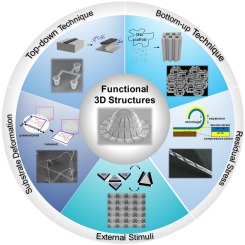当前位置:
X-MOL 学术
›
Nano Today
›
论文详情
Our official English website, www.x-mol.net, welcomes your
feedback! (Note: you will need to create a separate account there.)
Nanofabrication approaches for functional three-dimensional architectures
Nano Today ( IF 13.2 ) Pub Date : 2020-02-01 , DOI: 10.1016/j.nantod.2019.100825 Hangbo Zhao , Yongjun Lee , Mengdi Han , Bhupendra K. Sharma , Xuexian Chen , Jong-Hyun Ahn , John A. Rogers
Nano Today ( IF 13.2 ) Pub Date : 2020-02-01 , DOI: 10.1016/j.nantod.2019.100825 Hangbo Zhao , Yongjun Lee , Mengdi Han , Bhupendra K. Sharma , Xuexian Chen , Jong-Hyun Ahn , John A. Rogers

|
Abstract Three-dimensional (3D) functional systems with sizes in the micro- and nanometer regime are of growing importance across a wide range of electrical, optical, and biological contexts. The unique functionalities of such platforms follow from engineering the shapes, geometries, and architectures of materials into 3D layouts. The main challenges are in developing techniques/methods with sufficient levels of resolution and with broad materials compatibility. The most successful routes include (1) top-down schemes that involve masking and selective material removal, often in repetitive sequences, (2) bottom-up strategies that rely on component assembly or materials deposition, (3) two-dimensional (2D) to 3D shape transformations triggered by internal forces or external stimuli, and more recently, (4) mechanically guided assembly driven by substrate deformations. This review highlights recent progress in these areas, with a focus on techniques with demonstrated capabilities in constructing functional 3D structures and/or devices with key dimensions in the nanoscopic regime, and on their demonstrated or potential applications.
中文翻译:

功能性三维结构的纳米制造方法
摘要 尺寸在微米和纳米范围内的三维 (3D) 功能系统在广泛的电气、光学和生物环境中变得越来越重要。这些平台的独特功能源于将材料的形状、几何形状和架构设计成 3D 布局。主要挑战在于开发具有足够分辨率和广泛材料兼容性的技术/方法。最成功的路线包括 (1) 自上而下的方案,包括掩蔽和选择性材料去除,通常是重复的序列,(2) 自下而上的策略,依赖于组件组装或材料沉积,(3) 二维 (2D)到由内力或外部刺激触发的 3D 形状转换,以及最近,(4) 由基板变形驱动的机械引导组件。本综述重点介绍了这些领域的最新进展,重点关注在构建具有纳米级关键尺寸的功能性 3D 结构和/或设备方面具有展示能力的技术,以及它们展示的或潜在的应用。
更新日期:2020-02-01
中文翻译:

功能性三维结构的纳米制造方法
摘要 尺寸在微米和纳米范围内的三维 (3D) 功能系统在广泛的电气、光学和生物环境中变得越来越重要。这些平台的独特功能源于将材料的形状、几何形状和架构设计成 3D 布局。主要挑战在于开发具有足够分辨率和广泛材料兼容性的技术/方法。最成功的路线包括 (1) 自上而下的方案,包括掩蔽和选择性材料去除,通常是重复的序列,(2) 自下而上的策略,依赖于组件组装或材料沉积,(3) 二维 (2D)到由内力或外部刺激触发的 3D 形状转换,以及最近,(4) 由基板变形驱动的机械引导组件。本综述重点介绍了这些领域的最新进展,重点关注在构建具有纳米级关键尺寸的功能性 3D 结构和/或设备方面具有展示能力的技术,以及它们展示的或潜在的应用。











































 京公网安备 11010802027423号
京公网安备 11010802027423号